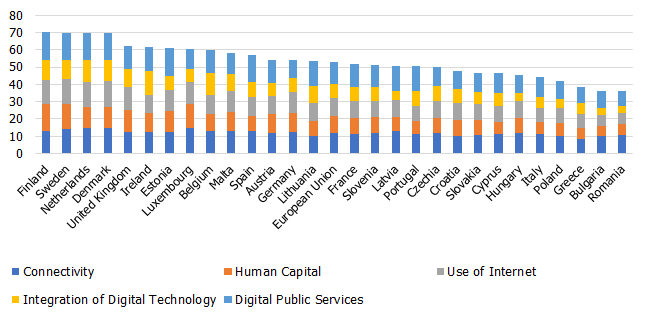Can we compete with artificial intelligence on the labour market?

Today, the advancement of digitalisation and artificial intelligence, sometimes referred to as the fourth industrial revolution, is one of the most topical issues among economy experts and policy-makers worldwide. This concept is not unfamiliar in Latvia either: lately, it has been discussed among industry professionals at nearly every conference or seminar.
This article looks at the current views on the opportunities and challenges of digitalisation and its automation capabilities, in relation to productivity and employment prospects in particular.
It is no secret that lately the productivity growth rates have been subdued in many developed countries. In Latvia, they have also moderated compared to their levels before the crisis when the economy saw very rapid growth. On a global scale, the productivity growth has been and will continue to be affected by factors such as demographic challenges (population ageing) and mounting government debt inhibiting policy efforts to introduce changes[1]. Meanwhile, some researchers believe that the existing statistical methods of data presentation simply might not reflect part of the productivity growth[2].
Productivity (average growth rate in the respective period; %)

In this context, the digitalisation of the economy comes with high expectations: the development of the internet of things, big data, 3D printing and sharing economy would make it possible to optimise the existing processes and unlock the potential for new development incentives. Examples are countless but some of the most notable and known to the Latvian public are the virtual assistants of the technology and entertainment company "Tet" and the Enterprise Register. Such new solutions allow us to save both material and human resources. Furthermore, they would enable us to improve our productivity over time. Already today, digital algorithms can replace workers in many occupations, allowing businesses worldwide to reduce costs and boost productivity.
Economists largely agree on the productivity gains of digitalisation, but their opinions on employment-related issues in this context vary greatly. There are two opposing views of how digitalisation will affect employment in the future. The first view holds that up to a half of jobs in the developed world will be automated in the coming 10 to 20 years. The share of automated jobs might be even larger in developing countries due to their employment structure[3]. Such rapid changes might result in mass unemployment. Meanwhile, those with the opposing viewpoint remind us that, historically, the replacement of labour with technologies has consistently led to the creation of new jobs, and they believe that digitalisation will also increase the demand for new professions. Time will show what will be the actual development. Either way, it is already clear that we can expect major changes, and policy-makers should prepare for them in good time.
Several empirical studies have shown that jobs are not only lost but also created in the process of digitalisation. For instance, a study conducted in Austria found that in more digitalised sectors the number of created jobs is five times higher than that of lost jobs (390 thousand created jobs vs 75 thousand lost jobs), while in less digitalised sectors the number of created jobs is almost half of those lost (189 thousand created jobs vs 280 thousand lost jobs)[4]. This indicates that the employment growth and the progress of digitalisation can be positively correlated in the economy. However, the technological development results in the creation of new jobs only under certain conditions.
Looking back at the experience of several industries over a prolonged period of time, James Bessen, researcher at the US Boston University School of Law, concludes that technological progress is more likely to create employment growth where demand for the industry product is highly elastic[5]. Namely, where the technological development allows making a product more accessible to a larger customer base and the demand for that product grows, businesses will need additional employees to produce increasingly larger quantities of goods and, thus, the number of new jobs will exceed the number of jobs lost due to automation. This is often typical of new sectors producing goods that are in early stages of their life-cycles and have not yet reached high market saturation. For instance, with the introduction of automated assembly lines, the automotive industry could significantly reduce the labour input per unit of output. At the same time, as the production costs declined, cars became much more accessible to consumers, and the number of the persons employed in the industry grew notably over time. However, where a product is already widespread, further production automation can lead to irreversible job losses in the industry. Therefore, the actual employment dynamics might depend on the extent to which the possibilities of digitalisation will be exploited to create new, in-demand and mass-produced products, in contrast to the optimisation of already established goods and services.
However, what matters is not merely the quantity of jobs but also their quality. The key words here are the polarisation of jobs or the rising wage inequality observed in the developed economies over the last decades[6]. With the middle-income class contracting further, the gap between employees with relatively lower skills and highly qualified employees is widening. Economists believe that, so far, it may have been affected by factors such as a decreasing significance of trade unions, tax policy changes as well as structural changes in consumption and lower technology development costs[7]. Will further digitalisation of the economy continue to widen this gap?
Even if the total number of jobs remained unchanged or increased due to further introduction of digital technologies, it is obvious that this process can significantly change the skills profile of in-demand employees.
This means that employees will have to adapt accordingly by learning and applying new knowledge and skills. Moreover, changes can take place quite rapidly, taking into account the low cost of digital technology reproduction. Under such circumstances, a situation may arise where both high demand for new employees and high unemployment exist simultaneously, as in-demand skills differ from those available on the labour market. Thus, policy-makers are facing major challenges when identifying the envisaged changes and making appropriate adjustments to the systems of education and retraining of the unemployed. In the Nordic and Baltic region, for instance, Finland has taken a number of steps to prepare its economy for the challenges posed by artificial intelligence[8]. Other countries will need to follow to maintain their global competitiveness.
How successful has the digitalisation of Latvia's economy been so far and what is Latvia's starting position in the race for digitalisation? One of the indicators demonstrating a country's readiness to introduce and use digital technologies, is the Digital Economy and Society Index (DESI) prepared by the European Commission.
Digital Economy and Society Index (2019)

In 2019, DESI ranked Latvia 17th among the European Union (EU) countries. Connectivity (fast and widely available broadband internet) and available digital public services, e.g. e-government services, as well as the introduction of open data principles have been assessed as Latvia's strengths. However, Latvia's indicators with respect to human capital and business criteria overall lag well behind the respective EU averages. The reasons therefore are the very weak basic digital skills of the population, the lack of information and communication technology specialists in the labour market and the rising demand for such specialists, as well as the relatively weak integration of digital solutions in businesses.
If nothing is done to improve these weaknesses, competitiveness will most likely deteriorate in the future on account of less digitalised and, thus, less productive labour.
This, in turn, can pose a number of challenges to policy-makers, i.e. structural unemployment due to skills mismatches, the weakening of international competitiveness of businesses, etc. As a result, we risk losing jobs not because of the advancement of digitalisation and artificial intelligence but because we are slower than our competitors in introducing these technologies.
What artificial intelligence solutions are developed in the Baltics?
Various artificial intelligence solutions are developed in the Baltics. Watch the video on our own smart technologies already used by Latvian, Lithuanian and Estonian businesses. The voice-over of this video was created by a robot – a tool of the language technology platform hugo.lv.
Bibliography
1. GORDON, Robert J. (2014). The Demise of U.S. Economic Growth: Restatement, Rebuttal, and Reflections. NBER Working Paper, No. 19895, 41 p. Available at: http://www.nber.org/papers/w19895
2. COYLE, Diane (2015). Why GDP Statistics are Failing us. US Chamber of Commerce Foundation. Available at: https://www.uschamberfoundation.org/article/why-gdp-statistics-are-failing-us
3. FREY, Carl Benedikt, OSBORNE, Michael A. (2013). The Future of Employment: How Susceptible Are Jobs to Computerisation? Oxford Martin School Working Paper, 72 p. Available at: https://www.oxfordmartin.ox.ac.uk/downloads/academic/The_Future_of_Employment.pdf
4. HAIDER, R. (n.d.). The impact of digitalisation on the quantity and quality of work. An Austrian perspective. Available at: https://blogs.lse.ac.uk/netuf/2018/06/26/the-impact-of-digitalisation-on-the-quantity-and-quality-of-work-an-austrian-perspective/
5. BESSEN, James E. (November 28, 2017). AI and Jobs: The Role of Demand. Boston University School of Law, Law and Economics Research Paper No. 17–46, 27 p. Available at SSRN: https://ssrn.com/abstract=3078715
6. GOOS, Maarten, MANNING, Alan, SALOMONS, Anna (2014). Explaining Job Polarization: Routine-Biased Technological Change and Offshoring. American Economic Review, vol. 104(8), pp. 2509–2526, Available at: http://personal.lse.ac.uk/manning/work/ExplainingJobPolarization.pdf
7. AUTOR, David H., DORN, David (2013). The Growth of Low-Skill Service Jobs and the Polarization of the US labor market. American Economic Review, vol. 103(5) pp. 1553–1597. Available at: https://www.ddorn.net/papers/Autor-Dorn-LowSkillServices-Polarization.pdf
8. MINISTRY OF ECONOMIC AFFAIRS AND EMPLOYMENT OF FINLAND (2017). Finland's Age of Artificial Intelligence. Available at: https://julkaisut.valtioneuvosto.fi/bitstream/handle/10024/160391/TEMrap_47_2017_verkkojulkaisu.pdf
_________________________________________________
[1] See Gordon (2014)
[2] E.g. Coyle (2015)
Textual error
«… …»







